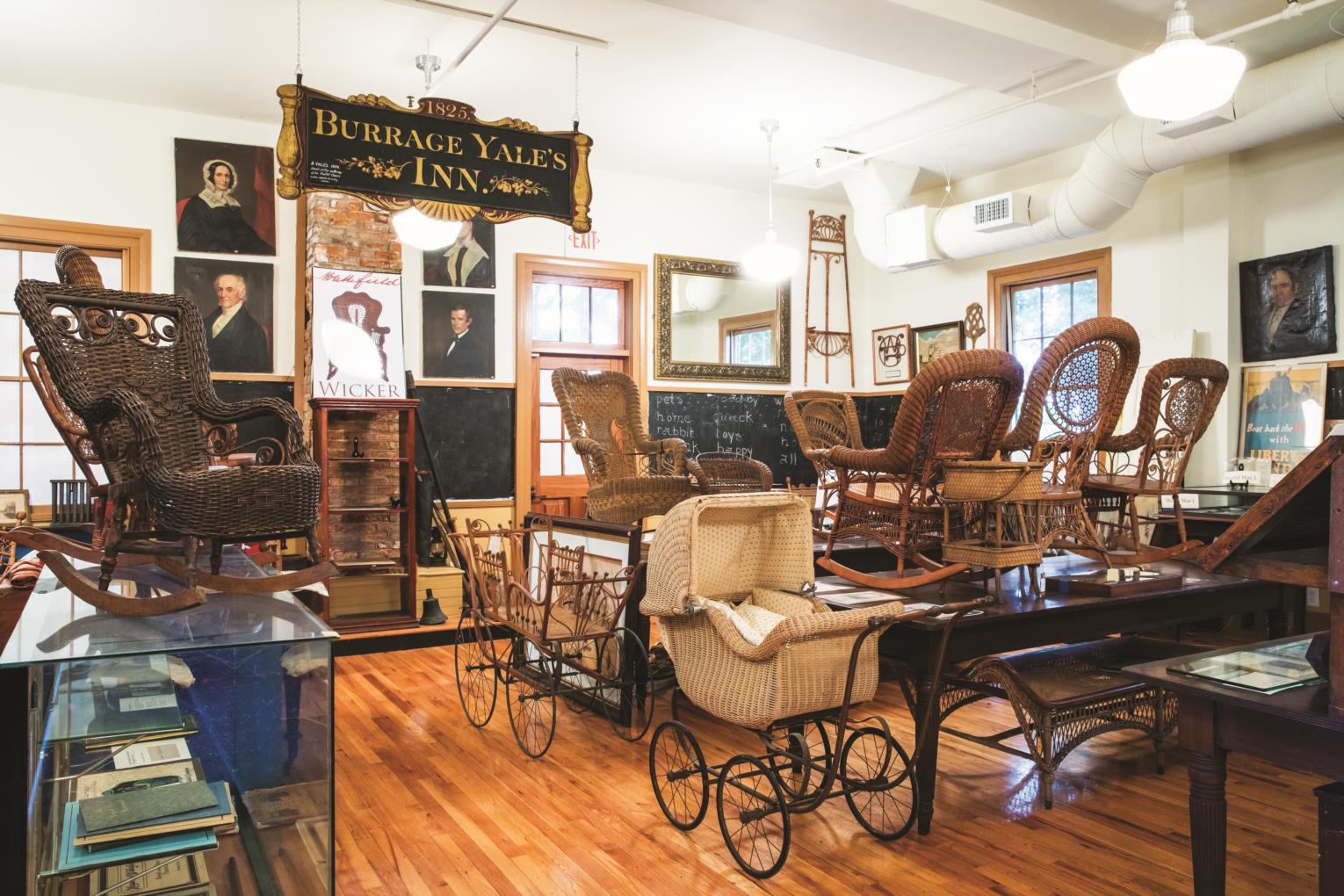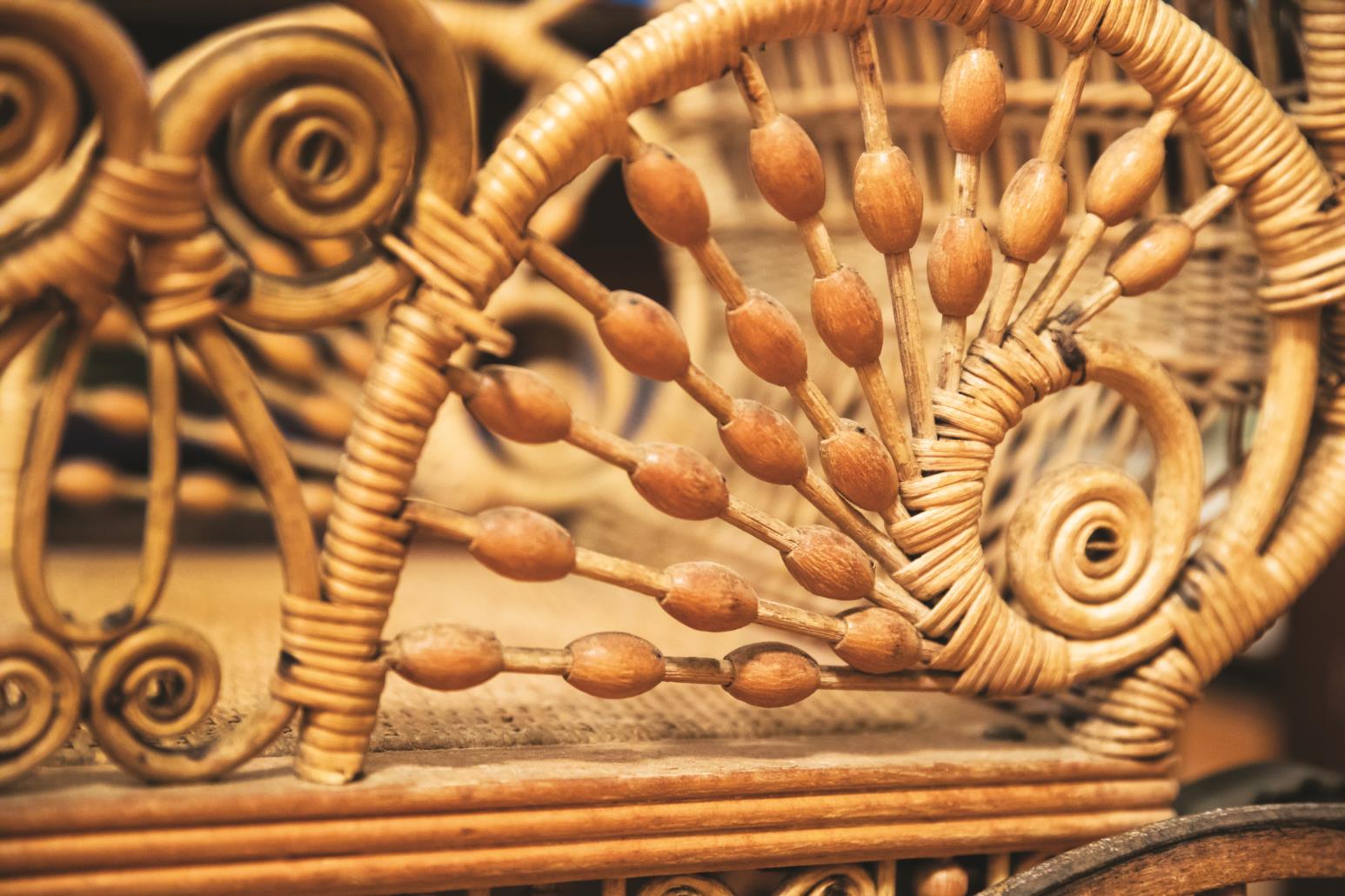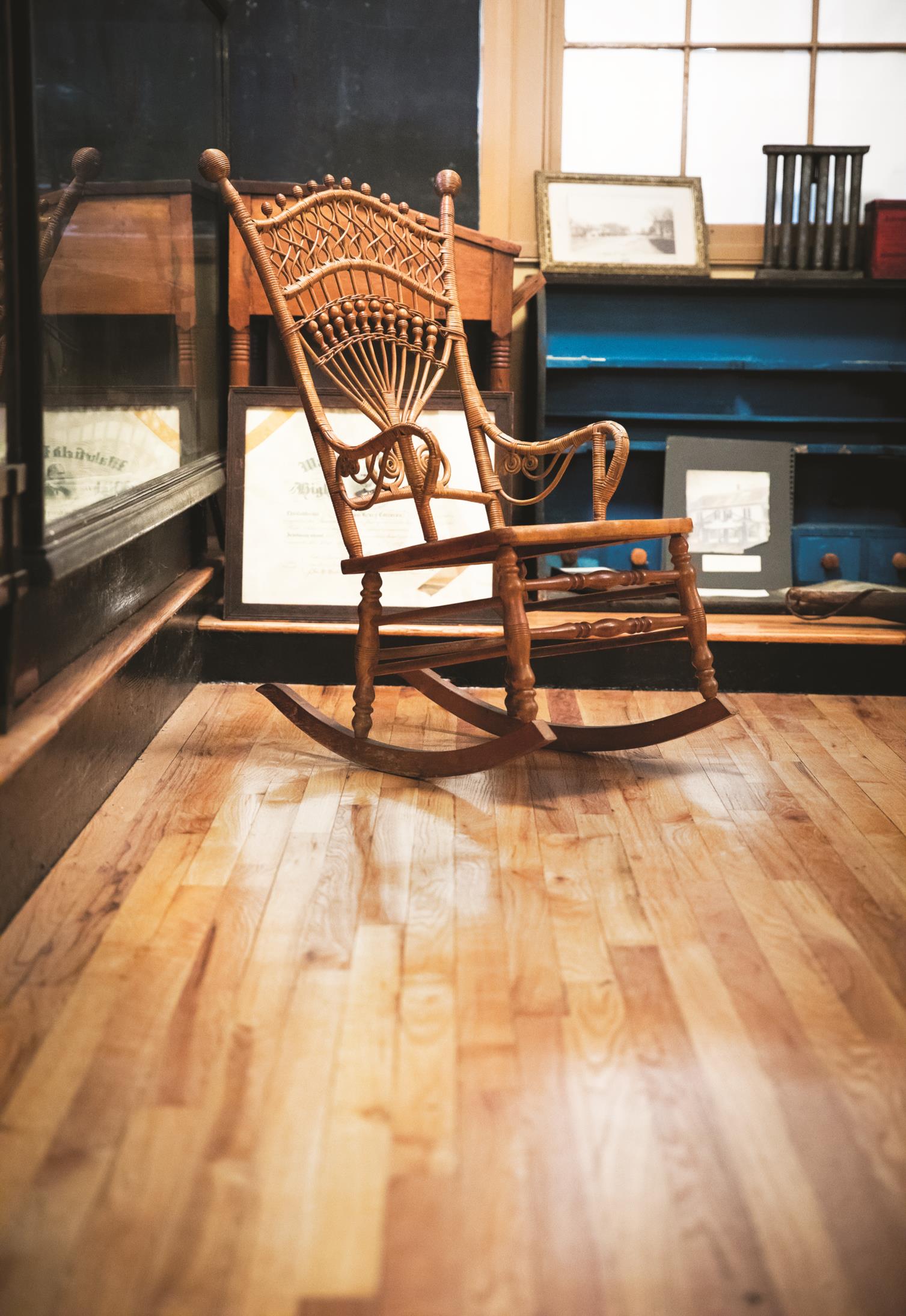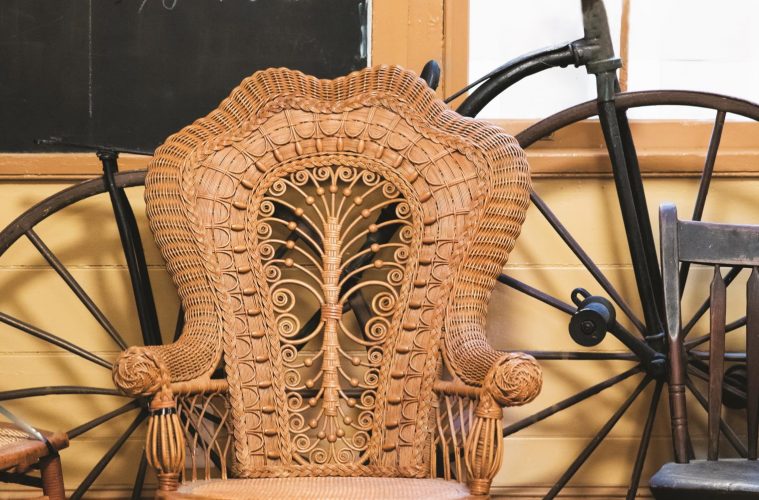 Part of wicker furniture’s charm was that nobody took it too seriously. Design historians shunned it because no one could decide whether it was a decorative art or a genuine craft. Still, it’s the most enduring form of furniture in history. Wicker was used by Sumerians 3,000 years ago; Egyptians enclosed woven items in their burial tombs. As the story goes, Moses was whisked away to safety in a reed basket, and Peregrine White, born in Cape Cod harbor in 1620 on the Mayflower, took his first nap in a Dutch-pattern wicker cradle, which now sits in a museum in Plymouth.
Prized authentic wicker, though, is the gold standard against which all styles are measured. Although the marketplace abounds with knockoffs and reproductions, none can compete with original wicker.
The word wicker derives from a blend of the Swedish words wika (“to bend”) and vikker (“willow”), referring to the woven baskets and basket-derived furniture made by European woodturners in the early 17th century and in New England after 1675. However, the word itself only gained widespread use after 1900, as an umbrella term for woven furniture and furnish ings crafted from a variety of natural, highly flexible vines such as rattan, cane, reed, willow, and other dried grasses. Since then, meanings have blurred. Though wicker endures in everyday usage, it actually refers to a style of weave; rattan is a material.
In the New World, wicker’s history is rooted in a North Shore community. Cyrus Wakefield was a young Boston grocer in 1844 who had a better idea for the bundles of rattan he saw abandoned on seaport docks, used originally as packing material in ships to keep cargo from shifting during long voyages from Asia. His keen imagination saw potential in the refuse, and he took a bundle home and experimented, wrapping strands around a chair frame.
Part of wicker furniture’s charm was that nobody took it too seriously. Design historians shunned it because no one could decide whether it was a decorative art or a genuine craft. Still, it’s the most enduring form of furniture in history. Wicker was used by Sumerians 3,000 years ago; Egyptians enclosed woven items in their burial tombs. As the story goes, Moses was whisked away to safety in a reed basket, and Peregrine White, born in Cape Cod harbor in 1620 on the Mayflower, took his first nap in a Dutch-pattern wicker cradle, which now sits in a museum in Plymouth.
Prized authentic wicker, though, is the gold standard against which all styles are measured. Although the marketplace abounds with knockoffs and reproductions, none can compete with original wicker.
The word wicker derives from a blend of the Swedish words wika (“to bend”) and vikker (“willow”), referring to the woven baskets and basket-derived furniture made by European woodturners in the early 17th century and in New England after 1675. However, the word itself only gained widespread use after 1900, as an umbrella term for woven furniture and furnish ings crafted from a variety of natural, highly flexible vines such as rattan, cane, reed, willow, and other dried grasses. Since then, meanings have blurred. Though wicker endures in everyday usage, it actually refers to a style of weave; rattan is a material.
In the New World, wicker’s history is rooted in a North Shore community. Cyrus Wakefield was a young Boston grocer in 1844 who had a better idea for the bundles of rattan he saw abandoned on seaport docks, used originally as packing material in ships to keep cargo from shifting during long voyages from Asia. His keen imagination saw potential in the refuse, and he took a bundle home and experimented, wrapping strands around a chair frame. Gradually, he worked with other craftsmen, constructing crude chairs and tables, and he also became a jobber of rattan, supplying furniture makers with repurposed reeds. Through savvy speculation he cornered the rattan market in America and prospered in the monopoly he created. Eventually he left the grocery business to his brother to work full-time on his smart idea.
Nancy Bertrand, president of the Wakefield Historical Society and a local antique dealer, says, “Cyrus Wakefield and the wicker industry came along at just the right time, tapping into the Japonism movement that was sweeping the country.” Wicker furniture designers found inspiration in the exotic and novel designs. “That kind of style was really welcome,” she adds.In 1855, Cyrus Wakefield formed the Wakefield Rattan Company, settling his huge manufacturing operation in South Reading. As demand accelerated over the next two decades, the company prospered and became the premier asset of the local economy, and in time employed over 1,000 townspeople.
With his largesse, Wakefield donated land and $30,000 to build a new town hall. Immediately, a town meeting voted to rename the town Wakefield in his honor, sealing immortality for his family name. However, because of additional elaborate and expensive features (up to $100,000 worth) not in the original plan, a building committee decided to “leave the erection of the building to the liberal donor,” records show.
In 1873, Cyrus Wakefield died suddenly, and his nephew, who deliberately changed his name to Cyrus Wakefield II, took over management of the business. By then, Heywood Brothers & Company was an established giant in manufactured wood furniture based in Gardner, and it engaged the Wakefield Company in a fierce rivalry during the 1870s and ’80s. Finally, in 1897, the two companies merged into Heywood Brothers & Wakefield Company, expanding in the United States and in Europe.
Gradually, he worked with other craftsmen, constructing crude chairs and tables, and he also became a jobber of rattan, supplying furniture makers with repurposed reeds. Through savvy speculation he cornered the rattan market in America and prospered in the monopoly he created. Eventually he left the grocery business to his brother to work full-time on his smart idea.
Nancy Bertrand, president of the Wakefield Historical Society and a local antique dealer, says, “Cyrus Wakefield and the wicker industry came along at just the right time, tapping into the Japonism movement that was sweeping the country.” Wicker furniture designers found inspiration in the exotic and novel designs. “That kind of style was really welcome,” she adds.In 1855, Cyrus Wakefield formed the Wakefield Rattan Company, settling his huge manufacturing operation in South Reading. As demand accelerated over the next two decades, the company prospered and became the premier asset of the local economy, and in time employed over 1,000 townspeople.
With his largesse, Wakefield donated land and $30,000 to build a new town hall. Immediately, a town meeting voted to rename the town Wakefield in his honor, sealing immortality for his family name. However, because of additional elaborate and expensive features (up to $100,000 worth) not in the original plan, a building committee decided to “leave the erection of the building to the liberal donor,” records show.
In 1873, Cyrus Wakefield died suddenly, and his nephew, who deliberately changed his name to Cyrus Wakefield II, took over management of the business. By then, Heywood Brothers & Company was an established giant in manufactured wood furniture based in Gardner, and it engaged the Wakefield Company in a fierce rivalry during the 1870s and ’80s. Finally, in 1897, the two companies merged into Heywood Brothers & Wakefield Company, expanding in the United States and in Europe. Tastes are forever changing, and by the 1930s interest in wicker had waned, but it never really died out. Something about wicker’s delicate intricacy, airy charm, whimsy, and durability, coupled with its fabulous history, eventually attracted renewed appreciation. Other revivals followed in the 1960s and ’70s, and yet another trend was inspired by a superb exhibition in 1993 at the Smithsonian Institution’s Renwick Gallery of the National Museum of American Art in Washington, D.C., About 90 percent of the 80 displayed pieces were made by the Wakefield Rattan Company or Heywood Brothers & Wakefield Company.
Of course, there have been additions and variations on Wakefield’s original styles over the years. Originally wicker capitalized on warm, natural wood hues, but along the way green and white paint were layered on, lending a sprightly feel to the textured reeds. An open-weave alternative to the closely woven—and costly—styles came to be known as Bar Harbor wicker after the popular Maine resort town.
Wicker techniques are still taught in arts and crafts classes to keep the traditional craft alive. But new technologies use synthetic resin in place of organic reeds, making the popular Mission style, with its emphasis on single horizontal and vertical lines and flat panels, reasonably affordable. In 2015, a rounded wicker was introduced with portly proportions in a whimsical variation.
Still, those lucky enough to own authentic wicker pieces cherish them as heirlooms. Bertrand says, “The enormous breadth of design and function of wicker in Cyrus Wakefield’s time still adds to its universal appeal today. With the Industrial Revolution, life for many was getting a little easier, so there was more leisure time. People wanted to take advantage of the outdoors. Heywood Brothers & Wakefield Company came along at the perfect time. Cyrus Wakefield was lucky.”
Tastes are forever changing, and by the 1930s interest in wicker had waned, but it never really died out. Something about wicker’s delicate intricacy, airy charm, whimsy, and durability, coupled with its fabulous history, eventually attracted renewed appreciation. Other revivals followed in the 1960s and ’70s, and yet another trend was inspired by a superb exhibition in 1993 at the Smithsonian Institution’s Renwick Gallery of the National Museum of American Art in Washington, D.C., About 90 percent of the 80 displayed pieces were made by the Wakefield Rattan Company or Heywood Brothers & Wakefield Company.
Of course, there have been additions and variations on Wakefield’s original styles over the years. Originally wicker capitalized on warm, natural wood hues, but along the way green and white paint were layered on, lending a sprightly feel to the textured reeds. An open-weave alternative to the closely woven—and costly—styles came to be known as Bar Harbor wicker after the popular Maine resort town.
Wicker techniques are still taught in arts and crafts classes to keep the traditional craft alive. But new technologies use synthetic resin in place of organic reeds, making the popular Mission style, with its emphasis on single horizontal and vertical lines and flat panels, reasonably affordable. In 2015, a rounded wicker was introduced with portly proportions in a whimsical variation.
Still, those lucky enough to own authentic wicker pieces cherish them as heirlooms. Bertrand says, “The enormous breadth of design and function of wicker in Cyrus Wakefield’s time still adds to its universal appeal today. With the Industrial Revolution, life for many was getting a little easier, so there was more leisure time. People wanted to take advantage of the outdoors. Heywood Brothers & Wakefield Company came along at the perfect time. Cyrus Wakefield was lucky.”

